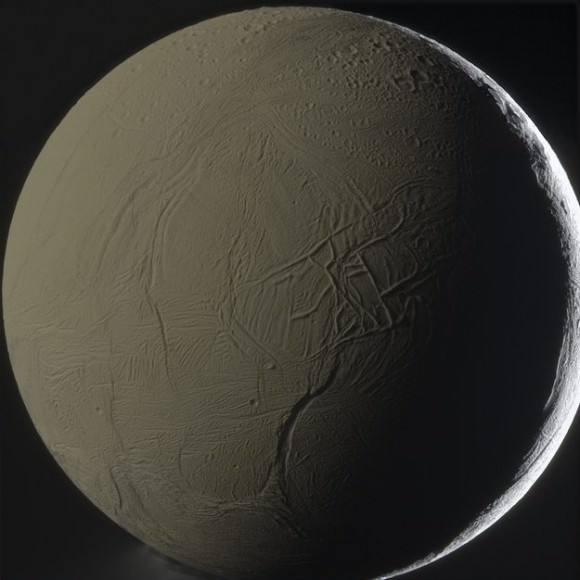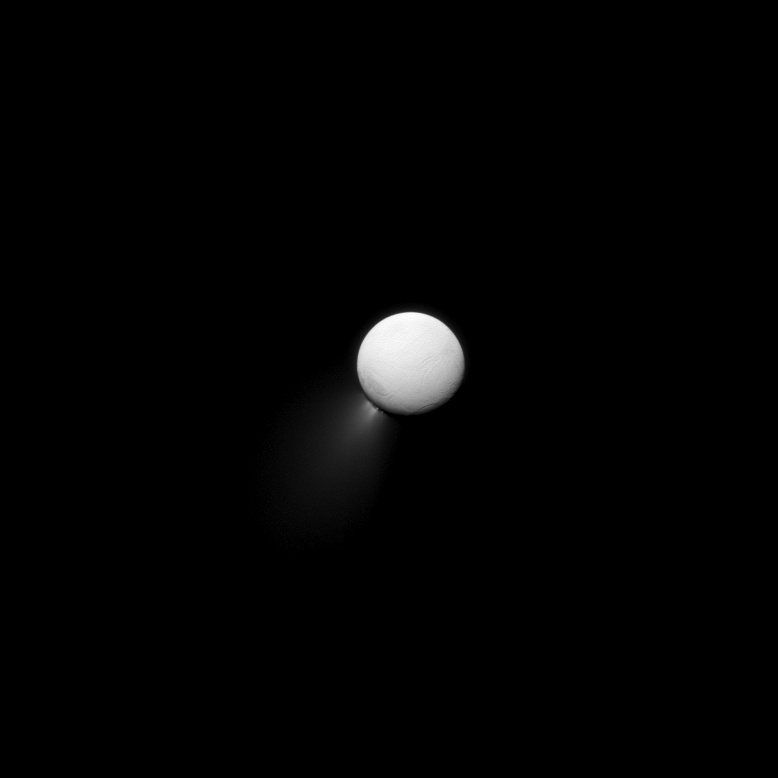According to planetary scientist and Cassini imaging team leader Carolyn Porco, about 98 geyser jets of all sizes near Enceladus’s south pole are spraying water vapor, icy particles, and organic compounds out into space. The spray from those geysers are evident in this new image from Cassini, showing a big, beautiful plume, illuminated by light reflected off of Saturn. Look closely to see that the plume is as large as the moon itself.
Cassini first discovered the jets of water ice particles in 2005, and since then scientists have been trying to learn more about how they behave, what they are made of and – most importantly – where they are coming from. The working theory is that Enceladus has a liquid subsurface ocean, and pressure from the rock and ice layers above combined with heat from within force the water up through surface cracks near the moon’s south pole. When this water reaches the surface it instantly freezes, sending plumes of ice particles hundreds of miles into space.
Read more: Enceladus’ Jets Reach All the Way to its Sea

Cassini has flown through the spray several times now, and instruments have detected that aside from water and organic material, there is salt in the icy particles. The salinity is the same as that of Earth’s oceans.
Enceladus is just 504 kilometers (313 miles) across, but it potentially could be one of the best spots in the solar system for finding life.
The top image was taken on January 18, 2013. This view looks toward the Saturn-facing side of Enceladus, and was taken when Cassini was approximately 483,000 miles (777,000 kilometers) from Enceladus. Image scale is 3 miles (5 kilometers) per pixel.
The second, face-on, color view of Enceladus was taken by the Cassini spacecraft on January 31 2011, from a distance of 81,000 km, and processed by amateur astronomer Gordan Ugarkovic.


Wouldn’t it be interesting to send a probe some day to orbit this moon for a year, gathering samples of this spray until you had several pounds worth saved, return to earth with the material for bacterial analysis? It could be analyzed on the space station if need be to avoid contamination of our planet perhaps….
I’m curious as to how much thrust these jets produce. Could it eventually alter the moon’s orbit? Just a thought.
can saltwater be inductively heated? we know it’s mildly conductive.
Just a thought!
Great question Dan! When I first saw the pic above. I was thinking more or less the same as you did. I also thought, how many of those “jets” go off at one time(?). However I did not think of the altering of the moon w/thrust itself. Again, your question has good merit ;-)… . ..take care.
I’m no expert in orbital dynamics, but I would think that Saturn’s gravity would counteract any thrust produced by the jets. Anyway, food for thought!